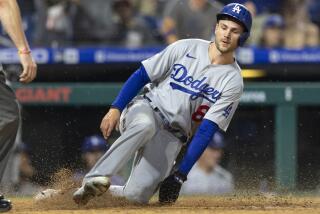Outfielders Use Eyes, Not Head : Perception: It’s the ball, not the wall, that players focus on, scientists find. And as their brains simplify the trajectory, they’ll make the catch--unless that wall gets in the way.
Nobody said a great outfielder had to be a rocket scientist. But it took a couple of scientists from NASA to figure out why fielders are constantly running into walls.
In a paper published today in the journal Science, perceptual psychologists Mary Kaiser at NASA Ames Research Center and colleague Michael McBeath, now at Kent State University, explain that fielders run into walls because their ability to catch fly balls is almost too good. Rather than attempting to compute where the curving ball is heading, as scientists had previously thought, the brain uses a simple rule of thumb to follow the ball’s straight trajectory as it leaves home plate.
“You’re confident you’re going to catch it, but you don’t know when,” McBeath said. “So you keep going, and all of a sudden, there’s a wall in front of you. If there weren’t walls in the way, (the fielders) could catch it.”
Four years ago, outfielder Rodney McCray crashed through the right-field wall of Portland’s Civic Stadium trying to catch a fly ball, which earned him a permanent place in baseball’s “off the wall” hall of fame. In the same year, Darryl Strawberry separated his left shoulder in an encounter with a wall at Dodger Stadium.
According to former Boston Red Sox pitcher Bill (Spaceman) Lee, the scientists haven’t discovered anything new. “Ballplayers knew this all along,” he said. “Scientists are always trying to explain great athletes, but great athletes don’t think.”
Kaiser and McBeath would agree. The visual cues that people use to catch balls on the fly are not that different from the automatic motion detectors built into the tiny brains of critters that catch flies on the wing: frogs. A frog “would have to use the same sort of optical cue to intercept the fly with its tongue,” Kaiser said. “And it might make a decent outfielder as well.”
Previous theories of how fielders catch balls assumed that brains solved calculus-like equations to be at the right place at the right time. But in laboratory studies, psychologists have found, people are not very good at judging acceleration or velocity changes.
“If you ask people to describe an object in free fall, they say its velocity is constant,” said Kaiser, even though a falling object falls faster the farther it falls. Fortunately, she said, “people act in a more sophisticated way than they’re able to describe.”
Kaiser’s work at the National Aeronautics and Space Administration focuses on visual clues that pilots use to know when they’re on a collision course with another plane, though the outfielder’s task is actually the opposite of the pilot’s. Whereas pilots are trying to avoid a plane on a collision course, the fielder wants his glove to be on a collision course with the ball. But the normal visual clues that people use to locate moving objects--such as changing size or depth perception--don’t work until the ball has traveled too far for the fielder to catch up.
Instead, the fielder keeps his eyes fixed on the ball in such a way that it appears to follow a straight trajectory from home plate. In reality, both the ball and the fielder follow curved paths. The fielder circles the ball while the ball follows a mostly parabolic path up and away from the plate.
But human brains are not very good at calculating where a ball will land. So the fielder adjusts his path, in effect canceling out the two curves. In his field of view, the ball angles up from the bat in a straight line.
McBeath was working with visual illusions as a postdoctoral student at Stanford University when he got interested in the trajectories of baseballs. “I heard a pro player talking (on TV) about how a certain pitcher had a rising fastball. And during the postgame show, Brett Butler mentioned that physicists had said a rising fastball was an illusion.”
*
Illusion or no, Butler insisted in the show, the ball appeared to hop up as much as a foot.
“And I thought, why do I study this stuff (perceptual illusions) that nobody cares about when I could be studying this stuff that’s right in front of our faces, and that lots of people care about?” McBeath said.
McBeath’s first scientific paper on baseball, published in 1990 in the journal Perception, explained the fastball’s rise as a sophisticated illusion similar to that in which a passing car can appear to speed up just as it goes by, because people tend to misjudge how fast it’s catching up to them.
Then he went to NASA, where he studied the kinds of visual illusions involved in pilot errors. With a background in physics and engineering, and a sister who is a Dodgers fan, McBeath has the credentials to investigate what scientists call the “optical flow” of objects such as baseballs.
To test their theory that a straight trajectory was the key to catching flies, the researchers videotaped students running to catch fly balls. They took some “God’s eye views,” as Kaiser called them, from above the field. They mounted video cameras on students’ shoulders, so they could keep the camera on the ball and catch it at the same time.
The experiments confirmed their theory.
“If it curves to the right, you run to the right,” McBeath said. “If it curves to the left, you run to the left. That way, you’ve got control over it.”
This maneuver explains, McBeath said, why fielders run to catch balls that are clearly headed for the stands--they’re so busy concentrating on the trajectory that they don’t know where it’s going.
Ballplayers such as Lee, however, don’t think much of the insights of scientists into baseball. “A long time ago, they had a scientist that said the curveball didn’t break. They said it was an optical illusion. And Dizzy Dean said, ‘I’ll optical illusion you to death.’ ”
More to Read
Go beyond the scoreboard
Get the latest on L.A.'s teams in the daily Sports Report newsletter.
You may occasionally receive promotional content from the Los Angeles Times.










